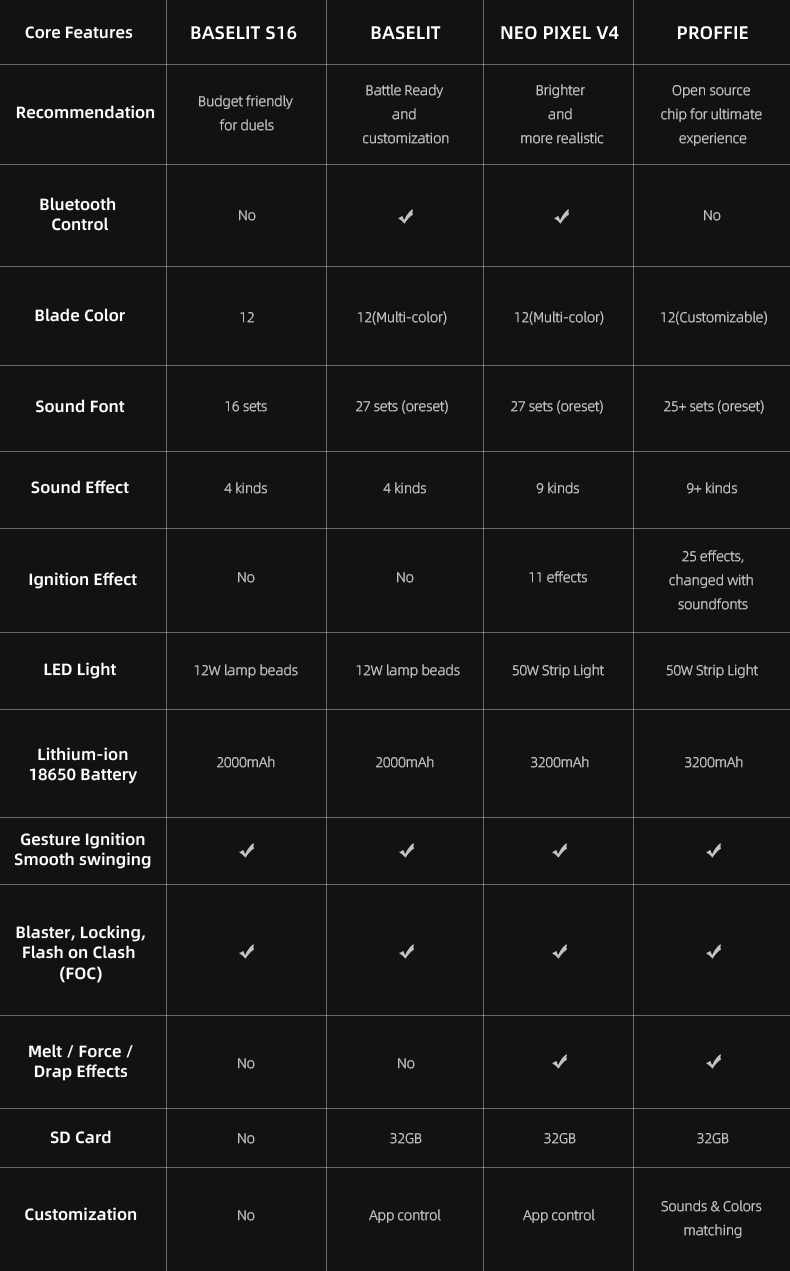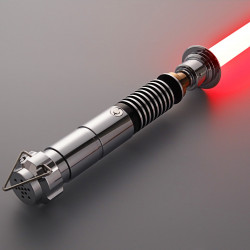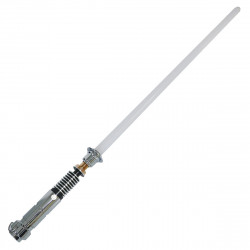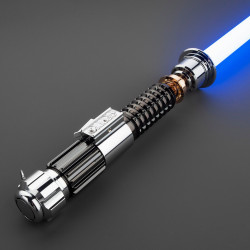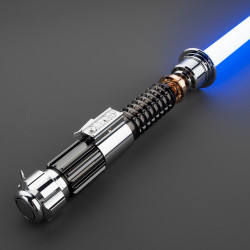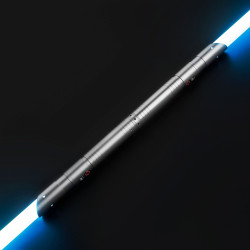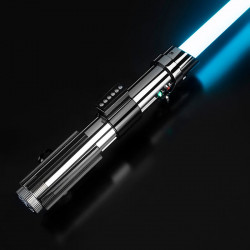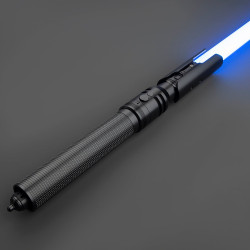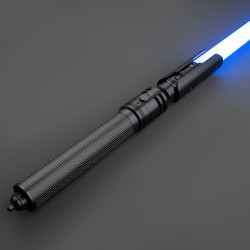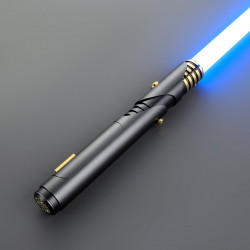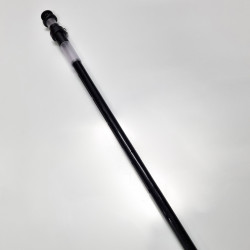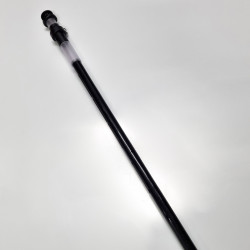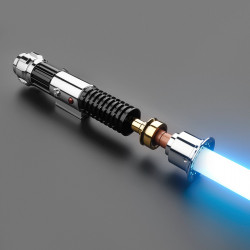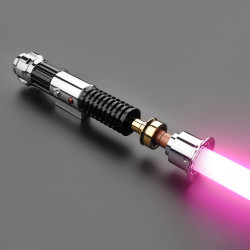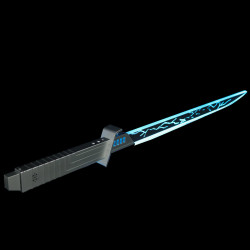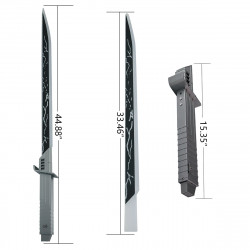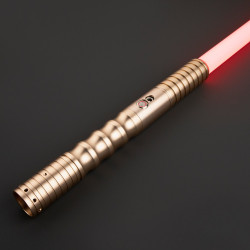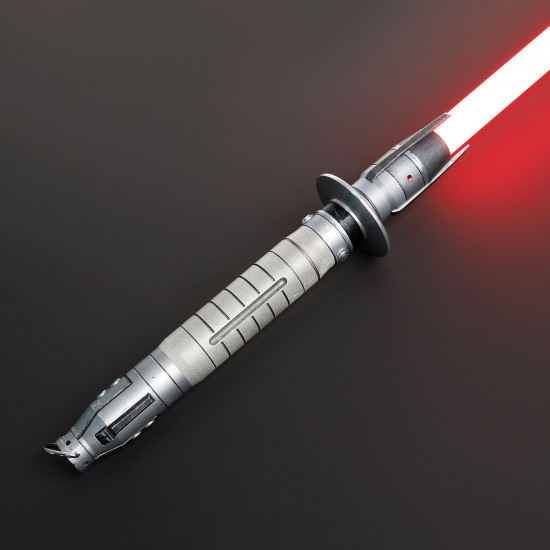
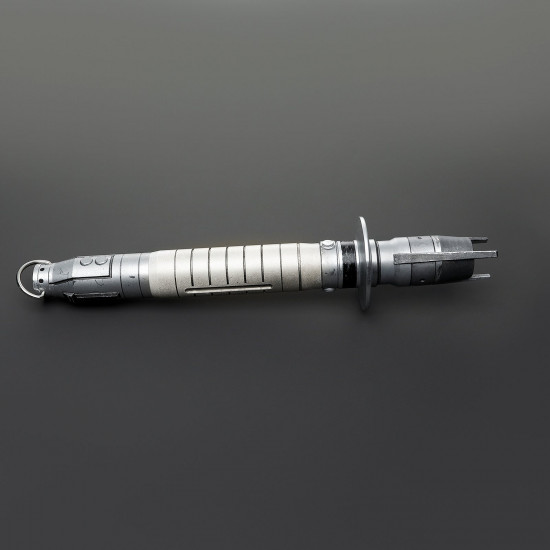
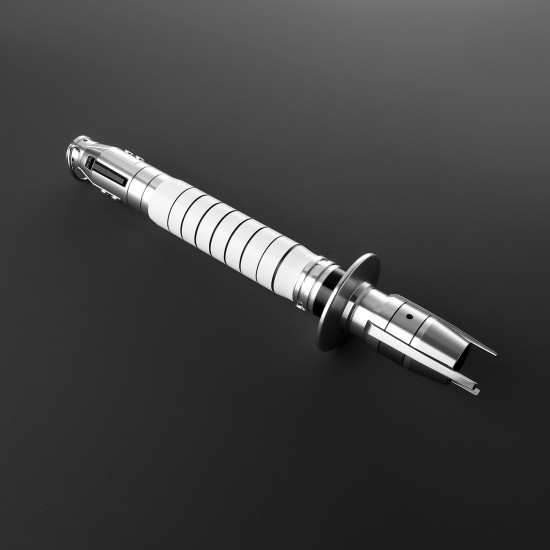
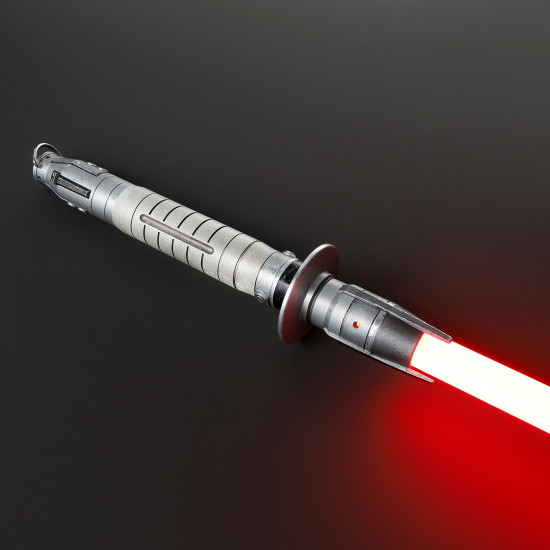
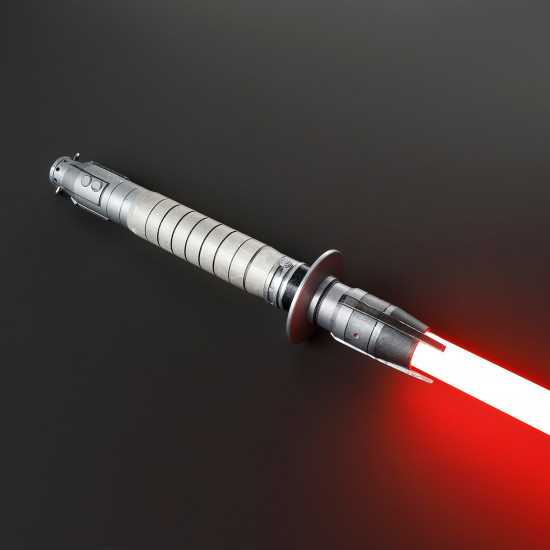
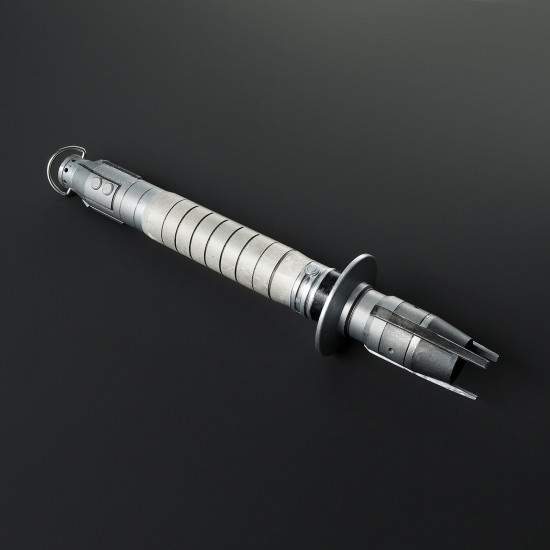
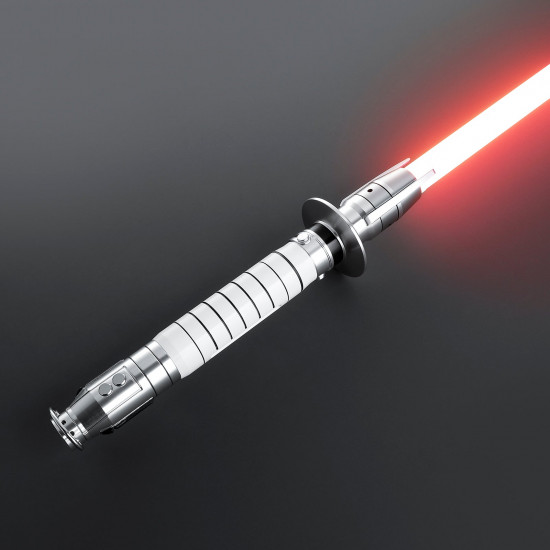
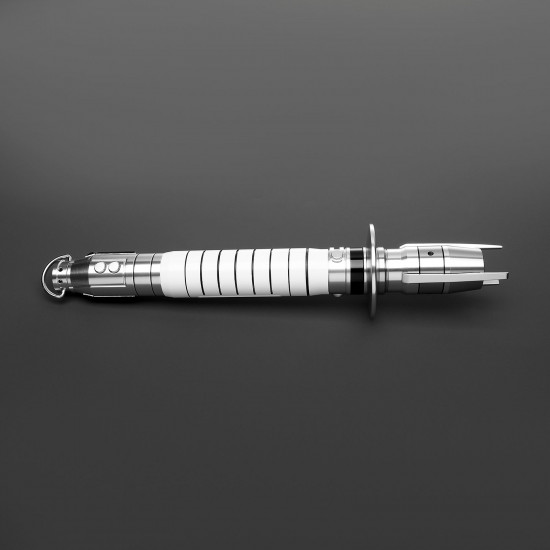
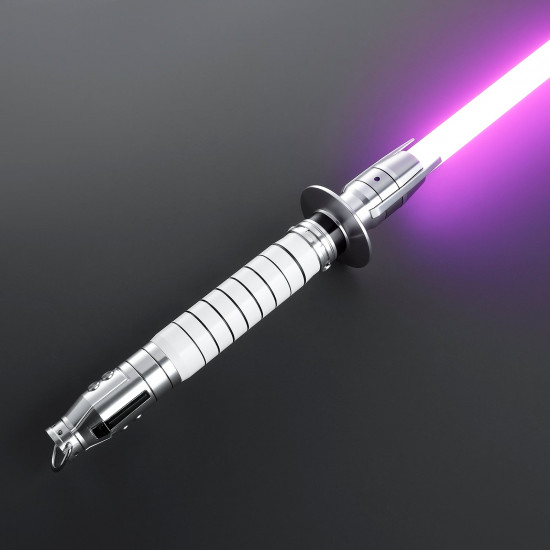
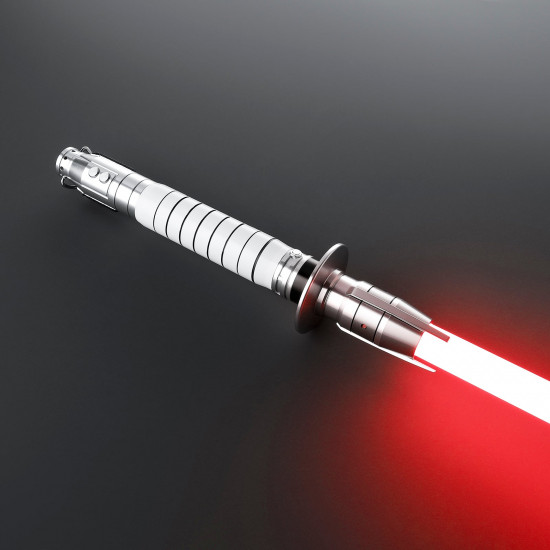
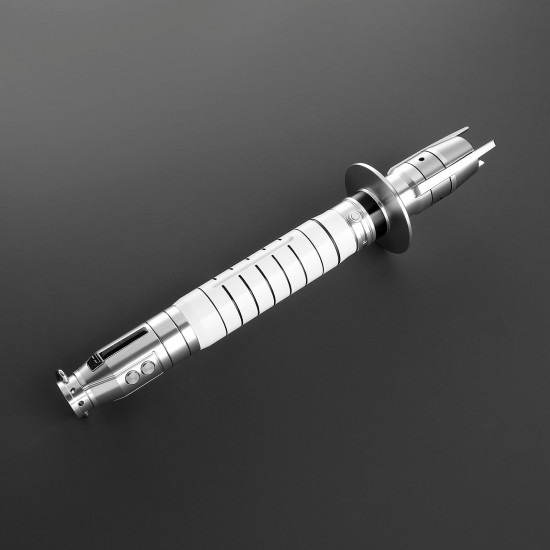
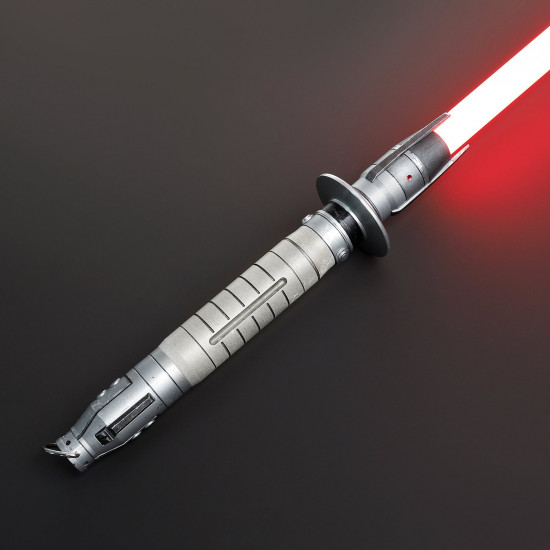












You will receive an email containing the order number and logistics information
US and Europe: 10-15 days
Other Regions: 15-20 days
Expedited can be sent to DHL, 3-7 days to arrive, the freight needs to be paid by yourself. Please contact us if necessary
TRACKING
1.Once the order is shipped, please allow 1-3 business days for the tracking number to be fully updated on the post office system. Please note that your order is actually on the way and there is no delay of the package rather than the tracking number status.
2.If you encounter any problems, please contact me via email.
PRODUCT INFORMATION
In Star Wars: Ahsoka, Shin Hati is Baylan Skoll's apprentice. And now you can have a replica of her lightsaber.
This is a saber replica, custom-built with tremendous precision and detail.
ADDITIONAL 1-week PRODUCTION TIME FOR WEATHERED VARIANT: the weathered look takes longer. It is a manual process, and no saber will look alike. It may end up looking different from the pictures.
Like all others, this magnificent saber has an aluminum 6063 hilt. Each saber has beautiful finishes and sturdy construction made of durable materials, providing the best re-creation of a legendary design or an incredibly comfortable and fashionable dueling weapon.
SABER CONFIGURATIONS
Here's a simple breakdown of our available configurations.
- Standard: the base model now has an Xeno 3 board and offers excellent audio, numerous effects, and customization via an SD card or smartphone app. Baselit sabers, designed for heavy dueling, have a lighter blade than standard sabers. It's ideal if you want to perform in stunt/duel performances or cosplay or don't require the Neopixel Blade.
- Premium : It's the choice we want the most! A Neopixel blade on the same brand-new Xeno 3 board. The blade's high-density LED strip provides an incredible appearance and many visual effects. Currently customizable via an SD card and, as always, a mobile app.
- Deluxe: For the programmers among you, the Proffie v2.2 board offers fully programmable styles and effects with just one function button. This is the best neopixel lightsaber available. You will adore this if you enjoy getting your hands filthy (mainly with your keyboard) and customizing objects around you!
DIMENSIONS
- Dimensions of the hilt: 32cm / 12.5 inches in length
- Dimensions of the blade: Select a length of 72, 82, or 92 cm (28, 32, or 36 inches). Instead of the conventional 1", the blade format is 7/8".For each 7/8" blade, the thickness of the polycarbonate is 2mm.
- Recommended length of your lightsaber: Many fencing federations and academies stipulate that the entire length of your dueling saber must not exceed 110cm (39.4 to 43.4 inches). Typically, the blade is 5 to 7 cm (2 to 3 inches) inside the hilt. If you intend to use your saber in a formal situation, select the correct size; if this bothers you, go for the more considerable blade length, which is 36 inches or 92 cm.
USABILITY CHART
Handling and weight are important factors for duelists, and style and ease of maintenance are essential for cosplayers. Style is vital for collectors.
STYLE & REFINEMENT
Minimal concessions were made for a lightsaber design that is gorgeous or accurate on screen.
HANDLING COMFORT
When a perfectly comfortable dueling hilt is combined with a unique design. An excellent middle ground.
WEIGHT
Replica sabers come with a weight and will be heavy for sports use.
MAINTENANCE
This saber comprises a slide-out core with a Core Matrix Hub or a two-part core. Access for maintenance is simple enough. The core has an easily accessible charging port.
XENO3 BLUETOOTH
With this hilt design, Bluetooth communication is minimal. During the process, you must slide the pommel or remove the core to set your saber's specifications via the app.
If you have any questions about our sabers, please get in touch with us through the chat; we speak English and French.
DETAILED SPECS
MAIN FUNCTIONALITIES
All of our sabers provide the following :
- Removable polycarbonate blade
- You can choose any color for your blade with the full RGB color picker or easy-access presets. Volume control from 0 to 100%
- Smooth swing: These lightsabers are incredibly motion-sensitive and respond to your every move with accurate buzzing sounds.
- Numerous sound fonts and blade styles are pre-loaded, with the option to add and modify your own (Xeno3 sounds and colors, complete control over Proffie).
- Hilts are built with aluminum 6063 and CE certified
- ON XENO3 ONLY: Free mobile app control and Bluetooth compatibility. Because of the thickness of the hilt, certain sabers have poor connectivity; the production description contains more information.
BLADE SPECS
- Baselit sabers are powered by a 12W LED module housed in the handle. Blades are designed for heavy dueling and have a diameter of 1 inch and a thickness of 2 mm.
- Neopixel blades with a full-length, high-density LED strip within are found in Premium and Deluxe sabers. See their description for additional details. Polycarbonate, either 1 inch in diameter and 3 mm thick or 7/8 inch in diameter and 2 mm thick. Although we do not recommend using the 3mm thickness for intense dueling because of the possibility of damaging the internal LED circuit, it is possible to duel with them. It is possible to purchase more blades with varying lengths, thicknesses, and widths.
- You may use the tip drag effect and smooth ignitions with the neopixel blades. The neopixel blades found in Premium and Deluxe sabers also significantly improve blaster effects, flash-on-clash, and saber lockups.
BATTERY AND BOARDS
- Rechargeable 3000mAh and 3600mAh batteries can run a saber for one to three hours, depending on whether it's a profile, neopixel, or basalt saber and the effects you're using.
- Never charge a USB device using a dongle, hub, fast charger, computer, or console—always use a 1A 5v USB charger. Inappropriate power outputs and charging devices will damage your board and void the warranty.
- If the port is visible, charging the battery can be done directly on the core (slide the core out or remove the grip part) or under the pommel piece.
- Every saber comes equipped with a recharge cable.
- Stock: In Stock
- Model: shin-hati-lightsaber
- SKU: shin-hati-lightsaber
- UPC: shin-hati-li
- ISBN: shin-hati-lightsa
- MPN: shin-hati-lightsaber
Available Options
Lightsaber Guide Rev.1.1
How to Choose a Lightsaber
The lightsaber's core, not the model, controls the igniting effect, sound font, color change, smooth swinging, and Bluetooth control. While lightsaber models may differ in their underlying structures, all of the lightsaber's features will remain the same as long as the core version remains the same. Every version at LaserPointerWorld has a pixel core.
Choose your preferred lightsaber model based on the hilt details.
Based on the hilt design specifics (such as character names, pattern information, and structural elements), choose the lightsaber model that best suits your needs.
Further customize the lightsaber's attributes based on your personal preferences.
A variety of hilt colors, traditional or weathered styles, 32- or 36-inch blade lengths, and straight or curved blades are available.
Select the lightsaber core that meets your functional requirements.
The core is the control center for all of the lightsaber's functions, determining the effects it can produce.
How to Use a Lightsaber
- Basic Usage
Finding the lightsaber core is the first step towards using one. You can check out LaserPointerWorld's tutorial manuals or the instructions that came with the package.
- App Control
You might also need to learn how to set up a Bluetooth connection and use an app to control lightsabers with S-RGB or SNV4 cores.

Customization
For lightsabers with SNV4 or Proffie cores, you may need to download configuration files. We provide a selection of configuration files for you to download.
- Recommended Tutorials
You can view videos tutorials from certain Jedi masters in addition to the official LaserPointerWorld tutorials. The following YouTube channel is suggested by us:
YouTube: @thefrugaljedi
After-Sales and Modifications
Since the core contains electronic chips, circuit or software issues may occur during installation. You can contact us for troubleshooting solutions.
Baselit RGB Lightsaber Operation Manual V1.1
Make sure your lightsaber has a single button or twin buttons before reading this guide.
It should be noted that lightsabers often have three states: active, standby, and off.
When your saber is in standby mode, the blade is not in use but it is still on and accepting inputs.
When your saber blade is in active mode, the LED is lighted and, if enabled, producing sound.
One button operation
1.1 While blade is in standby mode
1.1.1 Wake up
To go into standby mode, press and hold the button until the light turns on.
1.1.2 Power On
Tap the button.
1.1.3 Adjust volume (3 modes)
Once the breath indicator lights once, press and hold, then let go.
1.1.4 Change sound fonts
Once the breath light blinks twice, release the pressure that you applied.
1.1.5 Change BGM (3 types)
Release the hold after the breath light blinks three times.
1.1.6 FOC off/on
Hold and release when the breath light blinks four times.
1.1.7 Motion Control On/Off
Hold and release when the breath light blinks five times.
1.1.8 Power save mode
Hold down the button until the backlight turns off (it won't work for ten minutes).
1.2 While blade is active
1.2.1 Blaster
Tap the button.
1.2.2 Lock
After the breath light flashes once, hold down the button and let go.
1.2.3 Color Change
Hold until the breath light blinks twice, then release. Tap the button to exit this mode.
1.2.4 Change Blade Effects
Press and hold the button for three blinks of the breath light, then let go.
1.2.5 Turn Off
After the breath light flashes four times, hold down the button and let go.
1.3 Gesture operation in standby mode
1.3.1 Turn on
Twist the saber.
1.3.2 Change sound fonts
Holding the button with the blade up, twist the saber.
1.3.3 Change BGM
Holding the button pressed, rotate the saber while keeping the blade down.
1.4 Gesture operation in active mode
1.4.1 Turn off
Twist the saber.
1.4.2 Switch Blade Effects
Holding the button, twist the saber when the blade is up.
1.4.3 Change Color
Holding the button pressed, rotate the saber while keeping the blade down.
1.4.4 FOC
Strike the saber.
Two-button operation
PWR Button: Main Button, Power Button.
AUX Button: Auxiliary Button, Function Button.
(When the buttons are distributed up and down: Upper button is the main button, lower button is the AUX button; When the buttons are distributed left and right: Left button is the main button, right button is the AUX button)
2.1 While blade is in standby mode
When the batteries are inserted correctly, it beeps.
When charged properly, it beeps.
2.1.1 Power On
Tap the PWR button.
2.1.2 To change soundfonts
Tap the AUX button.
2.1.3 Adjust volume
Press and hold the PWR button, then release (mute/low volume/high volume).
2.1.4 Power save mode
Twenty minutes without operations.
2.2 While blade is active
2.2.1 Power off
Tap the PWR button.
2.2.2 Blaster
Tap the AUX button.
2.2.3 Lock
Hold down the AUX button for a moment, then let go.
2.2.4 FOC Off/On
Press and let go of the PWR button.
2.3 Gesture operation in standby mode
2.3.1 Power on
Rotate the saber.
2.3.2 Change sound fonts
Holding the AUX button while the blade is up, twist the saber.
2.3.3 Change BGM
Holding press the AUX button, twist the sword with the blade down.
2.4 Gesture operation in active mode
2.4.1 Turn off
Twist the saber.
2.4.2 Switch Blade Effects
Holding the AUX button while the blade is up, twist the saber.
2.4.3 Change Color
Holding press the AUX button, twist the sword with the blade down.
2.4.4 FOC
Hit the saber.
Note: For further information on how to use the lightsaber safely and in detail, please consult the user handbook that comes with it.
SNV4 Saber Operation Manual Rev.1.3
Make sure your lightsaber has a single button or twin buttons before reading this guide. It should be noted that lightsabers often have three states: active, standby, and off.
When your saber is in standby mode, the blade is not in use but it is still on and accepting inputs.
When your saber blade is in active mode, the LED is lighted and, if enabled, producing sound.
SNV4 Pro Lightsaber Operation Manual
One Button Operations
Charging: The power level alert will ring when you insert the charging wire. It will turn on the breathing light.
1.1 When the blade is in the power-off state
1.1.1 Switch between 82 and 92 blade types
Press the button three times in quick succession.
1.1.2 Wake up the blade
Long press the button.
1.2 While blade is in standby mode
1.2.1 Enter power-on mode
After the button has entered standby mode, briefly press it.
1.2.2 Enter power-off mode
① Press and hold the button until the blinking breathing light stops.
② Automatic shut-off after ten minutes if nothing is done.
1.2.3 Switch the volume
Once the breathing light blinks once, press and hold the button for a moment, then let go.
1.2.4 Switch power-on effects
Once the breathing light blinks twice, press and hold the button for a moment before releasing it.
1.2.5 Switch regular lighting effects
Once the breathing light blinks three times, press and hold the button for a moment before releasing it.
1.2.6 Switch sound effects
Once the breathing light blinks four times, press and hold the button for a moment before releasing it.
1.3 While blade is active
1.3.1 Enter standby mode
To put the device in standby mode, press and hold the button until the breathing light blinks four times.
1.3.2 Enter power-off mode
Hold down the button until the blinking breathing light stops.
1.3.3 Shockwave
Quickly tap the button.
1.3.4 LOCK-UP
Once the breathing light blinks once, press and hold the button for a moment, then let go.
1.3.5 Switch colors
Once the breathing light blinks twice, press and hold the button for a moment before releasing it.
1.3.6 Toggle FOC on/off
Once the breathing light blinks three times, press and hold the button for a moment before releasing it.
1.4 Gesture operations in standby mode
1.4.1 Reverse to switch sound effects
Tilt the blade upward, hold the button, and rotate.
1.4.2 Enable or disable BGM
Tilt the blade downward, hold the button, and rotate.
1.5 Gesture operations in active mode
1.5.1 Force
Hold the button, tilt the blade upwards, and then rotate.
1.5.2 Switch colors
Hold the button, tilt the blade downwards, and then rotate.
1.5.3 Drag
Tap the blade while holding down the button.
1.5.4 Melt
Press and hold the button while pushing forward horizontally.
1.5.5 Stab
Release the button and thrust forwards.
Two Button Operations
PWR button: Main button, power button.
AUX button: Auxiliary button, function button.
(When buttons are arranged vertically: upper button is the main button, lower button is the AUX button; when buttons are arranged horizontally: left button is the main button, right button is the AUX button)
Charging: Insert the charging cable, and the charging sound effect will play while the breathing light blinks.
2.1 When the blade is in the power-off state
2.1.1 Switch between 82/92 blade types
Press the main button three times quickly.
2.1.2 Enter standby mode
To switch to standby mode and hear the power-on sound effect, long press the main button.
2.2 While blade is in standby mode
2.2.1 Enter power-on mode
Press and hold the main button briefly to activate the device.
2.2.2 Enter power-off mode
To hear the power-off sound effect and switch to power-off mode, quickly press the AUX button three times.
2.2.3 Switch sound effects
Short press the AUX button once and then release.
2.2.4 Switch power-on startup effects
To hear the sound that corresponds with a successful switch, long press the main button.
2.2.5 Switch power-on default lighting effects
To hear the sound that corresponds with a successful switch, long press the AUX button.
2.2.6 Adjust volume
To access the volume setting mode, simultaneously press and hold the main and AUX buttons. push the main button briefly to raise the volume, then push the AUX button briefly to lower it. To hear the sound that indicates you are leaving the volume setting mode, press both buttons at the same time once again.
2.3 While blade is active
2.3.1 Enter power-off mode
Press the main button briefly to switch to power-off mode.
2.3.2 Shockwave
Short press the AUX button.
2.3.3 LOCKUP
To switch to LOCKUP mode, hold down the AUX button for a full second before releasing it. To get out of LOCKUP mode, briefly push the AUX button one more.
2.3.4 Toggle FOC on/off
To turn on or off FOC mode, press the main and AUX buttons simultaneously when the device is in power-on mode.
2.4 Gesture operations in standby mode
2.4.1 Reverse to switch sound effects
Tilt the blade upward, hold down the main button, and rotate.
2.4.2 Enable or disable BGM
Tilt the blade downward while holding down the main button, then spin.
2.5 Gesture control in active mode
2.5.1 Force
Hold the main button, tilt the blade upwards, and then rotate.
2.5.2 Switch colors
Hold the main button, tilt the blade downwards, and then rotate.
2.5.3 Drag
Hold the main button and tap the blade.
2.5.4 Melt
Hold the main button and thrust forwards horizontally.
2.5.5 Stab
Press the primary button and propel yourself forward.
SNV4 Lightsaber Operation Manual
One button operation
1.1 While blade is in standby mode
1.1.1 Enter standby mode
Hold down the button until the light comes on.
1.1.2 Adjust volume
Once the breath light flashes once, press and hold, then let go.
1.1.3 Toggle boot effect
Once the ventilation light blinks twice, press and hold the button for a moment, then let go.
1.1.4 Change blade effect
Press and hold until the breath light blinks three times, then release.
1.1.5 Change sound fonts
Press and hold until the inflation light blinks four times, then release.
1.1.6 Power save mode
automatically switches to power-saving mode after ten minutes of inactivity.
1.1.7 Enter boot status
Press the button to put the device in standby mode.
1.2 While blade is active
1.2.1 Blaster
Quick click on the button.
1.2.2 Lock
Once the breath light flashes once, press and hold, then let go.
1.2.3 Change Blade Color
Once the breath light blinks twice, release the pressure that you applied.
1.2.4 FOC on/off
Once the inflation light blinks three times, release the pressure that was applied.
1.2.5 Off
Press and hold until the inflation light blinks four times, then release.
1.3 Gesture operation in standby mode
1.3.1 Change tone fonts
Hold the button, point the blade upward, and turn the hilt.
1.3.2 Change BGM
Point the blade down, hold the button, and rotate the hilt.
1.3.3 Enter boot status
Twist on.
1.4 Gesture control in active mode
1.4.1 Twist off
Twist off.
1.4.2 Change blade color
Point downward, squeeze, hold, and rotate the handle.
1.4.3 Force
Hold the button, point the blade upward, and turn the hilt.
1.4.4 FOC
Tilt the blade.
1.4.5 Drag
Tilt the blade while holding the button.
1.4.6 Melt
Hold the button and push the blade horizontally forward.
Two-button operation
PWR Button: Main Button, Power Button.
AUX Button: Auxiliary Button, Function Button.
(When the buttons are distributed up and down: Upper button is the main button, lower button is the AUX button; When the buttons are distributed left and right: Left button is the main button, right button is the AUX button)
2.1 While blade is in standby mode
2.1.1 Switch sound fonts
Click the AUX button.
2.1.2 Adjust the volume
To access the volume adjustment mode, simultaneously press and hold the Main and AUX buttons. When the beep sounds, release the buttons. To adjust the volume, click the Main button to make it louder and the Sub button to make it quieter. Hold down the Main and AUX buttons until the beep sounds, then release them to exit this mode.
2.1.3 Change the boot effect
Once the beep sounds, press and hold the Main button for one second before releasing it.
2.1.4 To change the blade effect
After hearing the beep, press and hold the sub button for one second before releasing it.
2.1.5 Power Save Mode
automatically switches to low power mode after ten minutes of inactivity.
2.1.6 Enter Boot Status
Click the button after entering standby mode.
2.1.7 Power off
Click the AUX button three times.
2.2 While blade is active
2.2.1 Power off
Click the Main button.
2.2.2 Blaster
Click the AUX button.
2.2.3 Lock
Once the beep sounds, press and hold the main button for one second before releasing it.
2.2.4 FOC Off/On
By simultaneously pushing and holding the main and AUX buttons, FOC can be turned on or off.
2.3 Gesture operation in standby mode
2.3.1 Change the sound fonts
Point the blade up, hold the AUX button, and rotate the hilt.
2.3.2 Change BGM
Point the blade down, hold the AUX button, and rotate the hilt.
2.3.3 Enter boot status
Twist on.
2.4 Gesture operation in active mode
2.4.1 Twist off
Twist off.
2.4.2 Change Blade Color
Point the blade down, hold the AUX button, and twist the hilt.
2.4.3 Force
Point the blade up, hold the AUX button, and rotate the hilt.
2.4.4 FOC
Tilt the blade.
2.4.5 Drag
Hold the main button and tilt the blade.
2.4.6 Melt
Hold the AUX button and push the blade horizontally forward.
Note: For further information on how to use the lightsaber safely and in detail, please consult the user handbook that comes with it.
Proffie V2.2 Saber Operation Manual Rev.1.1
It should be noted that lightsabers often have three states: active, standby, and off.
When your saber is in standby mode, the blade is not in use but it is still on and accepting inputs.
When your saber blade is in active mode, the LED is lighted and, if enabled, producing sound.
PWR Button: Main Button, Power Button.
AUX Button: Auxiliary Button, Function Button.
(When the buttons are distributed up and down: Upper button is the main button, lower button is the AUX button; When the buttons are distributed left and right: Left button is the main button, right button is the AUX button)
1 Two-button operation
1.1 Main operation
1.1.1 Power On/Off
Verify that the batteries are in the lightsaber properly, and listen for the beep that signifies standby mode. When not in use, it's advised to take the batteries out of the lightsaber.
1.1.2 Activate/Deactivate Lightsaber
You may toggle the lightsaber on or off by pressing and releasing the primary button.
1.1.3 Mute Mode
Double-clicking the main button will start mute mode and turn the lightsaber on silently when it is off.
1.1.4 Motion Control
To turn on or off the lightsaber, turn the handle.
1.2 While blade is in standby mode
1.2.1 Adjust the Volume
To enter or exit the volume adjustment mode, long press and hold the main and auxiliary buttons simultaneously until you hear a "beep" sound. To boost the volume, briefly push the main button; to decrease it, briefly press the auxiliary button.
1.2.2 Switch Sound Effects
Single-click the auxiliary button.
1.3 While blade is active
1.3.1 Blaster Block
Single-click the AUX button.
1.3.2 FOC (Flash-on-Clash)
The lightsaber will automatically flash white and emit a sound when it comes into touch or collides.
1.3.3 Drag Floor Effect
Press and hold the primary button while tapping the blade's tip.
1.3.4 Background Music
Long press the main button to activate or deactivate the background music.
1.3.5 Change Color
Hold down the Auxiliary button while the lightsaber is on, then swiftly hit the Main button. To alter the lightsaber's color, slowly turn the hilt after hearing the prompt sound. After the prompt sound, simply press the main button to end the color change mode.
One button operation
2.1 Main operation
2.1.1 Initial Setup
Verify that the battery is inserted correctly and that the prompt sound is audible. Make sure the lightsaber is in standby mode. When not in use, it is advised to take the battery out of the lightsaber.
2.1.2 Motion Control
To open or shut the lightsaber, quickly move the handle with your right hand, then your left.
2.2 While blade is active
2.2.1 Close Blade
Long press the button.
2.2.2 Blaster Block
To activate the blaster, click the button; to lock-up, hold down the button and tap the lightsaber.
2.2.3 Stab
Thrust the lightsaber horizontally forward.
2.2.4 Melt
Press the button and advance the lightsaber.
2.2.5 Lightning Block
Press and hold the button twice, then let go.
2.2.6 Drag Floor Effect
Press and hold the button while tapping the blade's tip.
2.2.7 Force
Raise the blade to the surface, depress the button, and quickly rotate the handle to the left and right.
2.2.8 Change Color
Depress the button, crank the handle fast, and push the blade down. To alter the color of the blade, slowly rotate the handle after hearing the cue sound. To lock the color, quickly turn the handle after pressing and holding the button one more.
2.2.9 Battle Mode On/Off
Press the button three times, and then press it once more.
2.3 While blade is in standby mode
2.3.1 Turn On
Click the button.
2.3.2 Turn BGM On/Off
Double-click the button.
2.3.3 Silent Open Blade
Press and hold the button twice, then let go.
2.3.4 Switch Sound
Release the button after pressing it.
2.3.5 Volume Adjustment Mode
To activate the volume adjustment mode and hear the "drop" prompt, press the button and tap the lightsaber. To adjust the volume, click the button and hold it down for a lower volume. To end the volume adjustment mode and hear the "drop" prompt, press the button once more and tap the lightsaber.
2.3.6 Power Prompt
Triple-click the button
Note: For further information on how to use the lightsaber safely and in detail, please consult the user handbook that comes with it.
Proffie vs Neopixel: Which Lightsaber Tech is Right for You
When discussing lightsabers, it's important to take into account their many variations and configurations. Many fans of the real lightsaber are actually not very familiar with it, especially when it comes to the confusion between Neopixel and Proffie lightsabers. This article will go into detail about the connections and differences between Neopixel and Proffie lightsabers, making it easier to understand and more convenient to use. In order to help you pick between the Neopixel and Proffie sabers and give you a better understanding of both, this essay will go into great detail about their differences and connections.
What are Neopixel and proffie lightsabers?
Prior to deciphering the distinctions between the two, it is imperative that we ascertain the definitions of Neopixel and Proffie lightsaber. Once these are established, it becomes effortless to differentiate between the two.
The lightsaber community did not inspire the name Neopixel. Nonetheless, lightsaber aficionados now frequently refer to lightsabers as having LED strips inside their blades. There are other distinct applications of that technology, such as Golden Harvest, Proffie, Xenopixel, and others. Thus, one of those technologies is meant when the term Neopixel is mentioned about lightsabers.
To begin with, Neopixel truly refers to a particular kind of blade. This type of blade differs from the RGB saber's blade in that it is made of LEDs and is distributed between several LED lights. As a result, the ignition effect of the RGB saber is different, giving rise to a different effect.
The proffie saber sets itself apart from the RGB and SN V4 variants with its distinct saber configuration. It is not the same as the Neopixel lightsaber in certain ways, but since it uses Neopixel blades, it is still a Neopixel. All of the features of a Neopixel saber are essentially included in the proffie saber; however, not every Neopixel saber has the same functionality as a proffie saber. For that reason, the main focus of this essay is the differences between the Neopixel saber's proffie and ordinary versions.
NEOPIXEL OR BASELIT?
Although the traditional RGB (baselit) lightsaber is adequate for active fighting, wealthy collectors will find the new neopixel technology far more appealing. With a brighter light and a unique radiance akin to what we've all loved in the movies, using a neopixel lightsaber offers a far richer experience.
Neopixel not only makes a lightsaber brighter, but it also adds versatility to its design. Neopixel sabers are made with many LED strips inside the blade as opposed to only the hilt. This implies that you have many greater options for colors, special effects, and customized animations.
Difference between Proffie and Neopixel Lightsabers
![]()
The most crucial first step is to distinguish between a Neopixel and a Proffie lightsaber. To put it simply, a Neopixel is a unique blade, while a Proffie is a particular kind of lightsaber core. While all Proffie lightsaber blades are Neopixel blades, they aren't always Proffie sabers; they could also be SN v4 blades.
A number of embedded LEDs set the Neopixel apart from the RGB, making it a superior blade that enables more intricate and varied lighting effects. The Proffie, the saber's central component, has the ability to be altered beyond its current capabilities, allowing users to modify the blades' color and sound. It also has an excellent soundboard that produces a unique sound effect.
Proffie vs Neopixel: Differences in Sound Version
Proffie lightsaber can be customized. The Proffie is an open-source platform with customizable fonts, blade styles, and other effects.
While the standard Neopixel cannot be altered on its own and has pre-installed sounds, it might be a better option for people who are not familiar with programming.
Proffie vs Neopixel: Difference in Blades
The standard Neopixel lightsaber offers a wide range of color options for the blade effects; the Neopixel can be changed from one color to another, and the different colored blades create a variety of visual effects; forms of the saber, like Djem So or Juyo, can be rendered smoothly, which when paired with the different colored blades, creates an amazing visual experience.
The Proffie saber, on the other hand, offers a greater range of customizable blade styles. More aggressive tactics are better suited for blades like Flame and Unstable, and Proffie owners can entirely customize the appearance of their blades to match their distinctive combat form.
Proffie vs Neopixel: The Dueling Experience Difference
The Neopixel lightsaber is a fantastic tool for fighting; its complex designs and shifting colors will make you stand out in combat. The Neopixel flashes a bright light simultaneously as if it were coming from your fingertips during moves like Soresu or Ataru, which makes for an incredibly comfortable dueling experience.
Though the Neopixel saber has a striking appearance, the Proffie offers a more intense fighting experience. Dueling is made incredibly lifelike by advanced technologies, such as impact sensors that faithfully replicate the crackling sound of swords colliding. The blade's intricate touch effects improve the dueling experience even more. Similar to a genuine combat, the clash detection feature keeps swords from locking up and causing injury. Proffie lightsabers, which are designed to provide a greater degree of immersion, are unmatched fighting tools for fighters aiming to learn more aggressive forms like Juyo or Vaapa.
WHAT CAN YOU DO WITH A NEOPIXEL LIGHTSABER?
First off, if necessary, you can engage in some light to medium level dueling. Although some damage is possible due to the flexible LED structure inside the blade, we advise against recreating the entire Darth Maul combat scenario.
Neopixel lightsabers provide cosplayers and collectors with a dream come true outside of combat. Your creativity is the sole restriction on the various configurations of blaster bolt deflection, unstable blade effects, animations, and blade scrolling effects.
Neopixel allows you to create a fully customizable lightsaber that imitates your preferred George Lucas character or, for a more customized experience, you can create an avatar outside of canon.
These constructions have the benefit of having separate LEDs that may be individually controlled for various effects. With this, you have far greater adaptability than with regular RGB baselit lightsabers. Everything else about the build is much the same. All of the electronics, batteries, and soundboards needed to improve your lightsaber experience are still housed in the hilt.
Neopixel technology is more power-hungry than RGB lightsabers, so bear that in mind. Despite using LED technology, they will consume up a battery more quickly. Consider bringing extra batteries if you intend to use your Neopixel lightsaber during a cosplay event or party.
Conclusion
In summary, the proffie lightsaber is a kind of Neopixel saber, but it's critical for buyers to recognize the distinctions between the two. Programming settings and customisation are supported by the proffie saber, which is crucial for individuals who enjoy creating their own lightsaber effects.
FAQs
1.What is a Proffie lightsaber?
A particular kind of modified saber known as a Proffie lightsaber makes use of the Proffieboard, an open-source sound and motion controller board made especially for fans. It has sophisticated blade profiles, sound effects, and customizing possibilities.
2.What are Neopixel lightsabers?
Neopixel blade technology is a feature of neopixel sabers. Neopixel blades have an inside string of individually addressable LEDs that enable more realistic ignition and retraction effects as well as scrolling patterns, making them more colorful and adaptable.
3.Can Proffie lightsabers utilize Neopixel blades?
It is possible for Proffie lightsabers to work with Neopixel blades. With the use of Neopixel technology, the Proffieboard offers a multitude of customizable blade effects, including color, intensity, flicker, and more.
4.Can I change the sound fonts on a Proffie lightsaber?
Yes, changing the sound typeface on a Proffie saber is one of its benefits. Sound fonts are sets of recorded sounds with various sword sound effects. By using the Proffieboard, you may customize the sound effects of your lightsaber and create a one-of-a-kind experience by switching between different sound typefaces.
5.How do Neopixel blades differ from traditional lightsaber blades?
Neopixel blades are not like regular lightsaber blades in that they have an inside strip of individual LEDs. More sophisticated and adjustable lighting effects are now possible, such as the ability to display various colors along the blade, create dynamic patterns, and create smooth color transitions.
6.Can Neopixel blades be removed from the hilt?
Neopixel blades can usually be taken out of a lightsaber's hilt by unscrewing or detaching them; this depends on the design and method of attachment. This makes it possible to store and move the saber more easily.
7.Are Proffie and Neopixel lightsabers suitable for dueling?
Dueling with Proffie and Neopixel lightsabers depends on how well-made and durable they are. Certain models are made with stronger materials to resist the impact of battle and are specifically intended for dueling. Before partaking in a strenuous dueling, it is crucial to review the manufacturer's specifications and recommendations.
8. Can I control Neopixel colors using Profffie?
A: Yes, Profffie allows dynamic color customization.
9.How is the Neopixel blade different from a traditional lightsaber blade?
Neopixel lightsabers are not like conventional lightsabers in that they employ an internal LED strip that is independent from the lightsaber itself. This makes it possible to create more intricate and adaptable lighting effects, such as dynamic patterns, seamless color changes, and the capacity to change the lightsaber's color.
Can Proffie boards control Neopixel lightsabers?
Neopixel lightsabers can be controlled by profi boards to produce better sound and lighting effects.
Are there any specific tools required for Proffie board customization?
Basic programming knowledge is necessary for customizing Proffie boards, and uploading your configurations to the device is done through an app like the Arduino IDE.
Do Neopixel lightsabers require special care or maintenance due to their advanced technology?
Neopixel lightsabers need to be handled cautiously to prevent damage to the internal LED strips and to prevent forceful hits.
Is there a community or forum where I can learn more about customizing Proffie lightsabers?
Indeed, there are a number of internet communities and forums devoted to customizing lightsabers, including thorough talks about programming the Proffie board.
Can Neopixel lightsabers be used in lightsaber duels, or are they too fragile?
Neopixel lightsabers are suitable for light-to-moderate battling and are often robust. Nevertheless, caution is advised because LED strips may be more fragile than conventional lightsaber technology.
Everything You Need to Know about Shin Hati Lightsaber
The Shin Hati Lightsaber is a sophisticated and distinctive saber that can be found in a galaxy far, far away. The owner of this enigmatic orange lightsaber is equally mysterious.
Prepare to go on this enigmatic journey to discover more about Shin Hati's saber as we unravel the mystery of Hati and her orange saber and examine everything unknown about its existence.
More Views:
1. Revan's Red and Purple Lightsaber's Development: The Jedi's Journey Toward Equilibrium
2. The Significance and Significance of Star Wars' Orange Lightsabers
3. The Orange Lightsaber and Baylan Skoll's Secrets
Shin Hati's background overview
Shin Hati was born on a secluded farming planet in the Outer Rim. Although she has always had a close bond with the Force, the harshness of her upbringing has prevented her from realizing its full potential. However, Hati occasionally experienced weird sensations around her, such as items moving without being touched or feeling other people's emotions. She found these sensations to be amazing.
Her parents are not happy about this, either, since they view this skill as witchcraft and are becoming increasingly terrified of it. Imperial recruits recognized an opportunity to relieve her of her "curse" and turned Shin Hati over to Imperial rule.
The Empire trained her as an inquisitor with the intention of using her abilities against the Jedi. Hati, however, refused to put up with the evil side's persecution. She always secretly longed for the Light Side. Hati exploded in pain after being brutalized by her master trainer, finally killing him and starting a defection.
Shin Hati was abandoned to wander as a renegade Force user. Until she ran upon Baylan Skoll, who had also deserted the Empire, that is. Baylan realized Shin could achieve more after noticing her talent. As if it were a revan, Skoll took her on as an apprentice and taught her the ways of the balance of light and darkness rather than the ways of the Sith.
Shin Hati learned to manage and use the Force under Skoll's guidance, and Skoll imparted his unusual belief that the Force belonged to everyone who could use it. She started as a mercenary and fashioned her first lightsaber, which had an orange blade to reflect her spirit of independence.
However, she and Skoll go with Morgan Elsbeth when he recruits them to take part in a plot against the New Republic. Hati thinks that Elsbeth may lead her to the exiled Admiral Thrawn. Skoll instructs Hati to get in touch with Thrawn, murder Raine and Bridger, and then assume her role in the upcoming Empire. Additionally, Skoll informs Hati that they will be parting ways. Hati called Thrawn for support in order to help take down Rayne and Bridger since her desire was pulling her in a different way than Skoll's.
Origin of Shin Hati Lightsaber
When she was very young, Skoll instructed Shin Hati to start creating her first lightsaber, which she did. In the thick forest close to Skoll's hut, Hati was immersed in meditation, trying to use the Force to communicate with the crystals buried in the earth. Following weeks of correspondence, Hati discovered a peculiar orange crystal that summoned her via the Force.
Hati got the orange crystal and started making her weapon. She meticulously engraved designs and glyphs onto the mechanism's metal shell and crystal. Hati made a lightweight alloy her lightsaber's material choice and crafted the hilt for maximum fighting agility. She set the energy modulation in sync with the crystals' power and lit the blade for the first time, illuminating the room with its characteristic orange glow.
Afterward, Hati experimented with and enhanced her lightsaber as her abilities grew. To enable a quick succession of strokes, she tried mounting small jet ventilation systems on both sides of the hilt. To accommodate various fighting forms, she additionally added a crystal chamber that enables her to alternate between single-bladed and double-bladed configurations. Hati, who has always been fearless in his inventiveness, even created a magnetic focusing lens system that regulates the blade's width and strength in response to commands, significantly enhancing the saber's performance.
What does Shin Hati's orange lightsaber mean?
Every saber color has a unique connotation. For example, the green and blue seen in Jedi weapons typically stand for justice and fairness, the Sith saber's red color denotes aggression and evil, and the Shin Hati lightsaber, In addition to being a very uncommon orange in the Star Wars world, it differs from the red saber of the Sith and the blue saber of the Jedi. Hati's maverick nature is reflected in this orange, which symbolizes her independence and adherence to ancient traditions.
The orange saber also represents Hati's internal struggle and equilibrium between light and dark. Although Hati studied under Jedi Knight Skoll, her quest for greatness also drew her to the dark. Her weapon represented her internal battle between Jedi and Sith, light and dark.
Another interpretation of the orange lightsaber is that it represents Shin Hati's insistence on himself and his refusal to let go of the past since, despite Hati's increasing strength, Hati makes sure that the original orange crystal remains at its center. The orange has seen Shin Hati's development and has preserved all of Hati's history. It functions as a biography of Shin Hati's life through the symbolic orange saber.
Who has ever wielded an orange lightsaber?
Plo Koon: He carries an orange lightsaber with a distinctive form. He uses a classic hilt design for his weapon. The initial setting was orange, but it was subsequently changed to blue.
Cal Kestis: In Fallen Order, Cal Kestis has the option to battle with an orange lightsaber.
Adel once invented a brand-new weapon with an orange blade, but the subsequent Star Wars settings removed it.
Is the orange lightsaber the weakest?
The user's skill mainly determines a lightsaber's strength. The differences between lightsabers of various colors are often minimal. The potency of the saber will depend on the user's skill, experience, and training, although with careful training, nearly any color blade can produce flawless results.
On the other hand, orange lightsabers could be the poorest saber color overall if I had to choose. Naturally, such strong users like Shin Hati are not among the orange sabers here. What makes the orange the least strong? A tiny proportion of orange saber crystals are constructed of a crystal termed colon as the core, rather than regular Kyber crystals, according to some information. The colon crystal and the Kyber crystal are similar, and they both can harmonize energy. At the microscopic level, however, the two are very different.
In contrast to a standard lightsaber with a Kyber crystal, a saber with this colon crystal will be less effective at cutting objects, showing that orange light The sword is the most vulnerable saber. The usual orange saber made of Kyber crystal, like Shin Hati's, is equally as powerful as a regular saber, but the blade made of colon crystal is obviously the weakest one stated here.
Ultimately, the user's skill still determines how strong a lightsaber is. It will not be feeble, regardless of the type of weapon, as long as it is sufficiently robust.
What color is the most potent lightsaber?
Purple is typically regarded as the most potent lightsaber color in the Star Wars universe. Purple lightsabers are as uncommon as orange sabers. Mace Windu and Darth Revan are the two most well-known users of purple sabers.
Because purple is typically thought of as existing in the middle of darkness and light, in the balance between the two, it can be said to be the strongest color. This indicates that it is associated with both sides of the Force, and Being able to use the two powers of light and darkness is a highly unique existence. When he loses control and gets enraged, he can even employ the power of darkness, just like Mace Windu, because he can unite two forces. He even invented Vaapad, a unique move. These are, without a sure, a potent symbol of the purple lightsaber.
Shin Hati lightsaber forms
As distinctive as Shin Hati's Force proficiency is her fighting style. She has built her unique style by combining several combat tactics instead of just one, building on the foundation of history.
Makashi: She can precisely target the enemy's weak places with her attack.
Soresu: This technique enables her blade to fend off enemy strikes.
Ataru: Capable of launching swift, continuous attacks that surprise the adversary.
Combination of "Shien" and "Djem So": Observe the opponent and be able to adapt to their attack, use several movements to counter their attack, and quickly end their offensive.
Combination Vaapad: Look for openings in the pandemonium and anticipate the opponent's offensive moves.
Important figures related to Shin Hati
As Shin Hati's first instructor, Baylan Skoll recognized her talent, helped her create an orange lightsaber, and taught her how to use a saber.
Aila Sekula: Shin Hati's friend with whom Hati developed a close bond. They evolved the lightsaber form together and fought alongside each other in combat. Hati was able to keep a balance between brightness and gloom because Secura provided her with support and consolation during her most trying period.
Master Yoda: Jedi Hati was put through a personal exam by Master Yoda to strengthen her character and strength. Hati gained a great deal of knowledge and expertise from Yoda during the Clone Wars.
Who were the important people that Shin Hati fought?
Das-Maradi: During the Battle of Velen District, Hati engaged in combat with Maradi, a fierce fighter. The two engaged in life-or-death combat as their lightsabers swung at lightning speed. Even though Hati ultimately prevailed, the battle caused permanent wounds.
Darth Nir: After leading the Sith forces to demolish the Jedi Temple, Nir and Shin Hati clashed. Ultimately, Hati disarmed Nighel by taking advantage of his aggression.
Darth Stryffy: Stryffy is crafty and manipulative. Hattie's acute Force abilities enabled her to recognize Stryphy's ploys and overcome him in early combat during the defense of Mon Cala.
Darth Maul: During the Clone Wars, Hati and Darth Maul engaged in bloody combat. She narrowly defeated Maul by using her agility and martial skills to counter his fierce strikes.
Darth Krayt: Hati's most formidable foe, Krayt, has shown his abilities are worthy of him from their final battle on Korriban to his first duel in the Sith Wars. Di. However, Hati gradually adjusted and kept improving her skills through practice and experience playing against other opponents, ultimately defeating Krayt.
Conclusion
We are in awe of this distinctive orange lightsaber, and as a legendary person in Star Wars, Shin Hati still has stories to tell us. A flawless duplicate of Shin Hati's saber may be found at LaserPointerWorld if you like to use it in real life. This will undoubtedly provide you with a realistic fighting experience and pave the way for your own Star Wars journey.
FAQs
1. What color lightsaber did Shin Hati use?
Orange was the color of Hati's first forged saber. Its center was made of orange Kyber crystal.
2. Is the orange lightsaber the weakest?
Some people indeed believe that sabers made of colonic crystals shine orange. However, they are thought to be significantly less powerful than a lightsaber made of kyber crystals. As a result, some people believe that orange is the weakest color.
3. What fighting form will Shin Hati use?
Shin Hati possesses several fighting forms, including Makashi, Soresu, Ataru, Shien and Djem So, Vaapad, and others, because she can integrate them and master the Force effectively.
4. Can the Shin Hati lightsaber be used in duels?
Shin Hati's lightsabers are made especially for battling. Their sturdy aluminum and polycarbonate construction allows them to endure the harshness of battle and offers a firm grip for accurate handling that prevents the lightsaber from falling off.
5. Does the Shin Hati lightsaber have sound effects?
The realistic sound effects of the Shin Hati saber add to the immersive experience. A range of noises are available to enhance your lightsaber combat experience, from the buzz of blades to the clang of blades.
6. Where can I buy a Shin Hati orange lightsaber?
You may purchase a variety of orange sabers from LaserPointerWorld in addition to Shin Hati Neopixel lightsabers.




